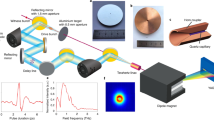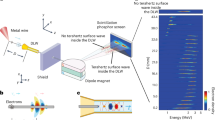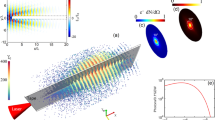Abstract
Acceleration and manipulation of electron bunches underlie most electron and X-ray devices used for ultrafast imaging and spectroscopy. New terahertz-driven concepts offer orders-of-magnitude improvements in field strengths, field gradients, laser synchronization and compactness relative to conventional radiofrequency devices, enabling shorter electron bunches and higher resolution with less infrastructure while maintaining high charge capacities (pC), repetition rates (kHz) and stability. We present a segmented terahertz electron accelerator and manipulator (STEAM) capable of performing multiple high-field operations on the six-dimensional phase space of ultrashort electron bunches. With this single device, powered by few-microjoule, single-cycle, 0.3 THz pulses, we demonstrate record terahertz acceleration of >30 keV, streaking with <10 fs resolution, focusing with >2 kT m–1 strength, compression to ~100 fs as well as real-time switching between these modes of operation. The STEAM device demonstrates the feasibility of terahertz-based electron accelerators, manipulators and diagnostic tools, enabling science beyond current resolution frontiers with transformative impact.
This is a preview of subscription content, access via your institution
Access options
Access Nature and 54 other Nature Portfolio journals
Get Nature+, our best-value online-access subscription
$29.99 / 30 days
cancel any time
Subscribe to this journal
Receive 12 print issues and online access
$209.00 per year
only $17.42 per issue
Buy this article
- Purchase on Springer Link
- Instant access to full article PDF
Prices may be subject to local taxes which are calculated during checkout






Similar content being viewed by others
Change history
24 April 2018
In the pdf version of this Article originally published, ref. 32, although correctly cited, was missing from the main reference list and instead listed in error at the end of the Methods section. This has now been corrected.
References
European X-Ray Free-Electron Laser Facility; https://www.xfel.eu/index_eng.html
Gao, M. et al. Full characterization of RF compressed femtosecond electron pulses using ponderomotive scattering. Opt. Express 20, 12048–12058 (2012).
Maxson, J. et al. Direct measurement of sub-10 fs relativistic electron beams with ultralow emittance. Phys. Rev. Lett. 118, 154802 (2017).
Floettmann, K. & Paramonov, V. V. Beam dynamics in transverse deflecting rf structures. Phys. Rev. Accel. Beams 17, 024001 (2014).
Ischebeck, R., Prat, E., Thominet, V. & Loch, C. O. Transverse profile imager for ultrabright electron beams. Phys. Rev. Accel. Beams 18, 082802 (2015).
Manz, S. et al. Mapping atomic motions with ultrabright electrons: towards fundamental limits in space-time resolution. Faraday Discuss. 177, 467–491 (2015).
Yang, H. et al. 10-fs-level synchronization of photocathode laser with RF-oscillator for ultrafast electron and X-ray sources. Sci. Rep. 7, 39966 (2017).
Peralta, E. A. et al. Demonstration of electron acceleration in a laser-driven dielectric microstructure. Nature 503, 91–94 (2013).
Breuer, J. & Hommelhoff, P. Laser-based acceleration of nonrelativistic electrons at a dielectric structure. Phys. Rev. Lett. 111, 134803 (2013).
Malka, V. et al. Principles and applications of compact laser–plasma accelerators. Nat. Phys. 4, 447–453 (2008).
Leemans, W. & Esarey, E. Laser-driven plasma-wave electron accelerators. Phys. Today 62, 44–49 (2009).
Guénot, D. et al. Relativistic electron beams driven by kHz single-cycle light pulses. Nat. Photon. 11, 293–296 (2017).
Salehi, F. et al. MeV electron acceleration at 1 kHz with <10 mJ laser pulses. Opt. Lett. 42, 215–218 (2017).
He, Z.-H. et al. High repetition-rate wakefield electron source generated by few-millijoule, 30 fs laser pulses on a density downramp. New J. Phys. 15, 053016 (2013).
Nanni, E. A. et al. Terahertz-driven linear electron acceleration. Nat. Commun. 6, 8486 (2015).
Walsh, D. A. et al. Demonstration of sub-luminal propagation of single-cycle terahertz pulses for particle acceleration. Nat. Commun. 8, 421 (2017).
Curry, E., Fabbri, S., Maxson, J., Musumeci, P. & Gover, A. Relativistic electron beam acceleration in a zero-slippage terahertz-driven inverse free electron laser scheme. Preprint at https://arxiv.org/abs/1708.06385 (2017).
Hebling, J., Almasi, G., Kozma, I. Z. & Kuhl, J. Velocity matching by pulse front tilting for large area THz-pulse generation. Opt. Express 10, 1161–1166 (2002).
Huang, S.-W. et al. High conversion efficiency, high energy terahertz pulses by optical rectification in cryogenically cooled lithium niobate. Opt. Lett. 38, 796–798 (2013).
Fülöp, J. A. et al. Efficient generation of THz pulses with 0.4 mJ energy. Opt. Express 22, 20155–20163 (2014).
Wimmer, L. et al. Terahertz control of nanotip photoemission. Nat. Phys. 10, 432–436 (2014).
Li, S. & Jones, R. R. High-energy electron emission from metallic nano-tips driven by intense single-cycle terahertz pulses. Nat. Commun. 7, 13405 (2016).
Huang, R. W. et al. Toward a terahertz-driven electron gun. Sci. Rep. 5, 14899 (2015).
Fallahi, A., Fakhari, M., Yahaghi, A., Arrieta, M. & Kärtner, F. X. Short electron bunch generation using single-cycle ultrafast electron guns. Phys. Rev. Accel. Beams 19, 081302 (2016).
Hebling, J. et al. Optical manipulation of relativistic electron beams using THz pulses. Preprint at http://arxiv.org/abs/1109.6852 (2011).
Huang, W. R. et al. Terahertz-driven, all-optical electron gun. Optica 3, 1209–1212 (2016).
Fakhari, M., Fallahi, A. & Kärtner, F. X. THz cavities and injectors for compact electron acceleration using laser-driven THz sources. Phys. Rev. Accel. Beams 20, 041302 (2017).
Fabiańska, J., Kassier, G. & Feurer, T. Split ring resonator based THz-driven electron streak camera featuring femtosecond resolution. Sci. Rep. 4, 5645 (2014).
Kealhofer, C. et al. All-optical control and metrology of electron pulses. Science 352, 429–433 (2016).
Döbert, S. et al. High gradient performance of NLC/GLC X-band accelerating structures. In Proc. Particle Accelerator Conference 372–374 (IEEE, 2005).
Massimo, D. F. et al. Experimental measurements of rf breakdowns and deflecting gradients in mm-wave metallic accelerating structures. Phys. Rev. Accel. Beams 19, 051302 (2016).
Wu, X. et al. High-gradient breakdown studies of an X-band compact linear collider prototype structure. Phys. Rev. Accel. Beams 20, 052001 (2017).
Kilpatrick, W. Criterion for vacuum sparking designed to include both rf and dc. Rev. Sci. Instrum. 28, 824–826 (1957).
Fallahi, A. & Kärtner, F. X. Field-based DGTD/PIC technique for general and stable simulation of interaction between light and electron bunches. J. Phys. B47, 234015 (2014).
van Oudheusden, T., de Jong, E. F., van der Ceer, S. B., Op’t Root, W. P. E. M. & Juiten, O. J. Electron source concept for single-shot sub-100 fs electron diffraction in the 100 keV range. J. Appl. Phys. 102, 093501 (2007).
Panofsky, W. K. H. & Wenzel, W. A. Some considerations concerning the transverse deflection of charged particles in radio-frequency fields. Rev. Sci. Instrum. 27, 967 (1956).
Cesar, D. et al. Demonstration of single-shot picosecond time-resolved MeV electron imaging using a compact permanent magnet quadrupole based lens. Phys. Rev. Lett. 117, 024801 (2016).
Wootton, K. P. et al. Dielectric laser acceleration and focusing using short-pulse lasers with an arbitrary laser phase distribution. AIP Conf. Proc. 1812, 060001 (2017).
van Tilborg, J. et al. Active plasma lensing for relativistic laser-plasma-accelerated electron beams. Phys. Rev. Lett. 115, 184802 (2015).
Gliserin, A., Walbran, M., Krausz, F. & Baum, P. Sub-phonon-period compression of electron pulses for atomic diffraction. Nat. Commun. 6, 8723 (2015).
Sciaini, G. & Miller, R. J. D. Femtosecond electron diffraction: heralding the era of atomically resolved dynamics. Rep. Prog. Phys. 74, 096101 (2001).
Acknowledgements
We gratefully acknowledge helpful discussions with C. Zhou, W. R. Huang, F. Ahr and W. Qiao, the expert technical support of T. Tilp, and M. Schust for fabrication of the STEAM devices used in this work. Besides Deutsches Elektronen Synchrotron (DESY) and the Helmholtz Association, this work was supported by the European Research Council under the European Union’s Seventh Framework Programme (FP7/2007-2013) through the Synergy Grant ‘Frontiers in Attosecond X-ray Science: Imaging and Spectroscopy’ (AXSIS) (609920) and the excellence cluster ‘The Hamburg Center for Ultrafast Imaging – Structure, Dynamics and Control of Matter at the Atomic Scale’ (CUI, DFG-EXC1074), the priority programme ‘Quantum Dynamics in Tailored Intense Fields’ (QUTIF) (SPP1840 SOLSTICE) of the Deutsche Forschungsgemeinschaft and the accelerator on a chip programme (ACHIP) funded by the Gordon and Betty Moore Foundation (GBMF4744). The authors also thank T. Y. Fan and J. Zayhowski from MIT Lincoln Laboratory for initial work on the cryogenic Yb:YLF laser within the AXIS Program funded by the Defense Advanced Research Projects Agency (DARPA) and DARPA for the loan of the laser. X.W. acknowledges support through a Georg Forster Research Fellowship of the Alexander von Humboldt Foundation and A.-L.C through a Helmholtz Postdoctoral Fellowship from the Helmholtz Association.
Author information
Authors and Affiliations
Contributions
F.X.K., D.Z., A.F. and N.H.M. conceived and coordinated the terahertz-driven electron acceleration and manipulation project. The structure was designed by A.F. and M.F. D.Z. designed the experimental setup and carried out the experiments. M.H., L.E.Z. and Y.H. built the Yb:YLF laser. A.-L.C. built the Yb:KYW laser with the help of H.C. X.W. and D.Z. built the terahertz setup. D.Z. built the ultraviolet generation and automated the setup. A.F. performed all simulations. A.-L.C., H.C., M.H., Y.H. and L.E.Z. maintained the laser systems and contributed with helpful discussions on the experiment. D.Z., A.F., N.H.M. and F.X.K. wrote the manuscript with revisions by all.
Corresponding author
Ethics declarations
Competing interests
The authors declare no competing interests.
Additional information
Publisher’s note: Springer Nature remains neutral with regard to jurisdictional claims in published maps and institutional affiliations.
Supplementary information
Supplementary Information
Supplementary notes and figures.
Supplementary Video 1
THz field development as a function of time inside the STEAM device.
Rights and permissions
About this article
Cite this article
Zhang, D., Fallahi, A., Hemmer, M. et al. Segmented terahertz electron accelerator and manipulator (STEAM). Nature Photon 12, 336–342 (2018). https://doi.org/10.1038/s41566-018-0138-z
Received:
Accepted:
Published:
Issue Date:
DOI: https://doi.org/10.1038/s41566-018-0138-z
This article is cited by
-
Free-electron crystals for enhanced X-ray radiation
Light: Science & Applications (2024)
-
Numerical investigation of sequential phase-locked optical gating of free electrons
Scientific Reports (2023)
-
Tilted pulse front pumping techniques for efficient terahertz pulse generation
Light: Science & Applications (2023)
-
Megaelectronvolt electron acceleration driven by terahertz surface waves
Nature Photonics (2023)
-
Subcycle surface electron emission driven by strong-field terahertz waveforms
Nature Communications (2023)



